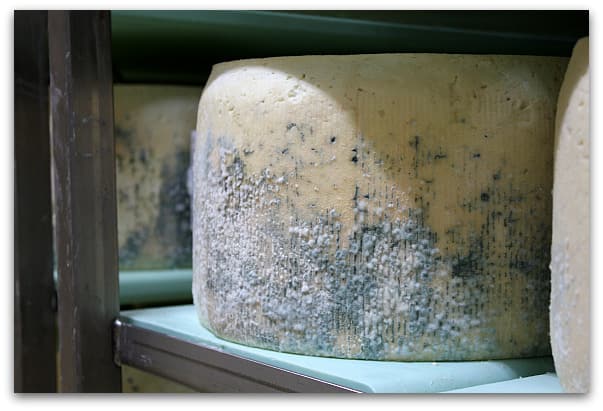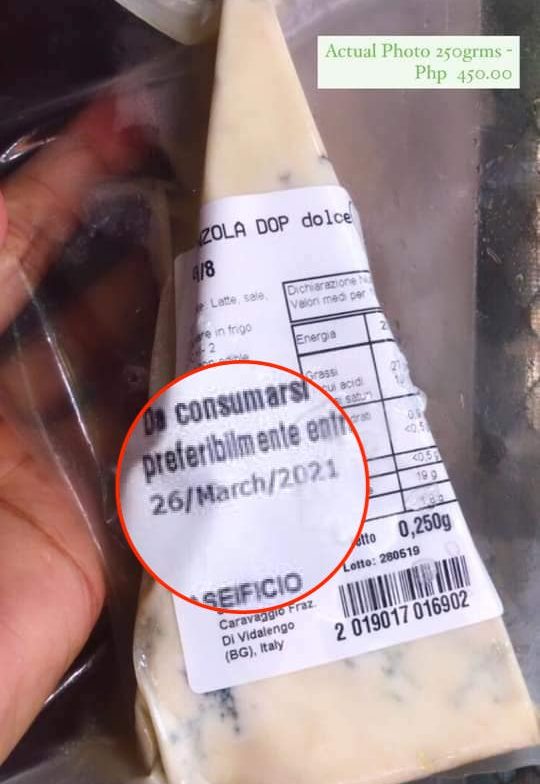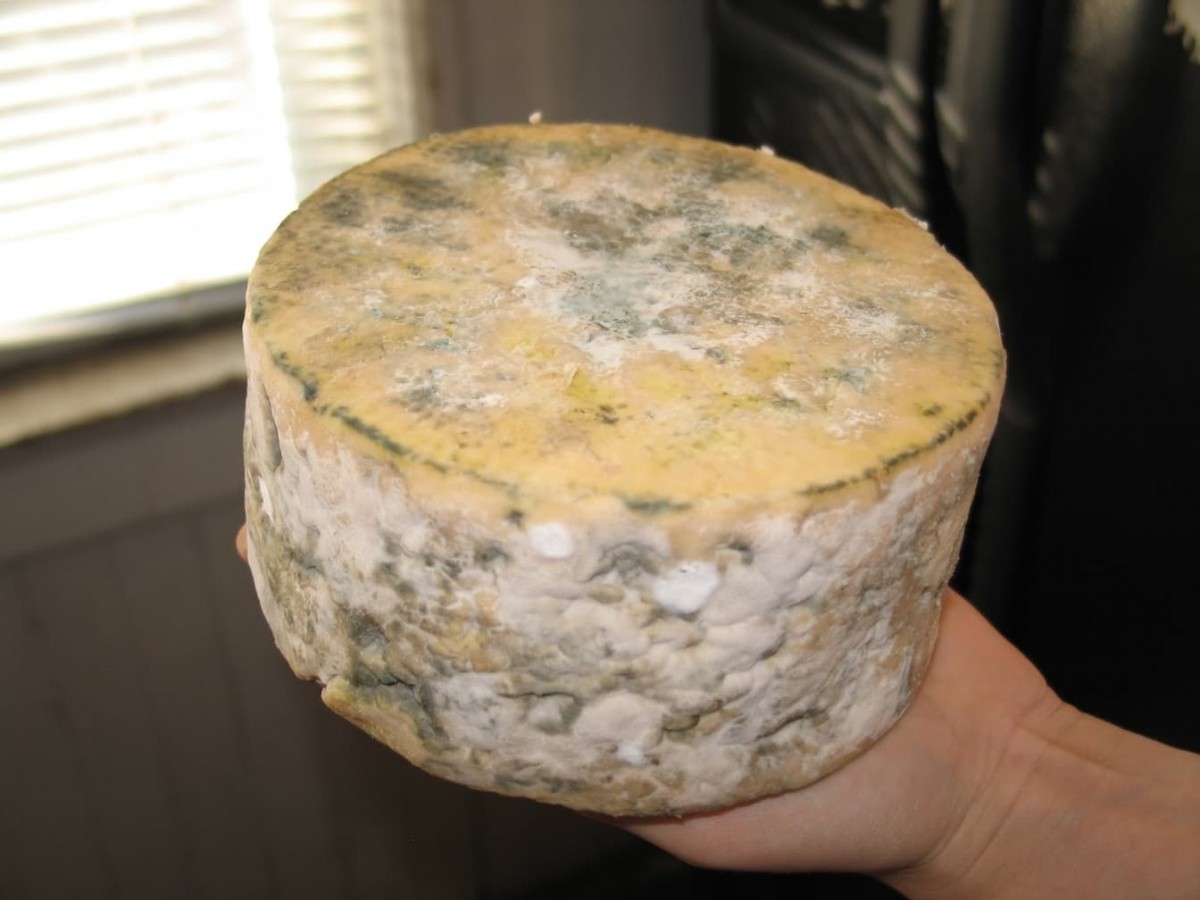Last Updated on March 23, 2024 by Aaron
Eww, It’s moldy! It must be spoiled, isn’t? It depends. You must be curious about how long does gorgonzola last once opened? and how to tell if it has gone bad? Here is the quick answer for you:
Normally, unopened gorgonzola can last 2-3 weeks in the fridge. If the package is opened, it will last for about a week or less. If sit out unrefrigerated, the mold/bacterial growth usually start to take place very quickly in just 4-10 hours. And, you may not spot them easy. If properly stored and past the expiration date, the gorgonzola might still be good to eat.
Gorgonzola is a blue cheese that has the beautiful blue-green veining pattern or spots. It’s because of the blooming of a type of mold called Penicillium glaucum which added during the cheesemaking. So, is gorgonzola supposed to be moldy?
Yes, gorgonzola is a mold-infested product – but not any random mold.
In fact, the whole wheel of cheese is likely to cover in mold and bacteria when aged for months. It’s common for workers to scrap off the mold before packing – for making it more appealing..
Eww, I know right..
But it’s totally safe to eat. The cheesemaking process has to be operated under a controlled environment for certain microorganisms to thrive, which often geographically bounded. That’s why some brands produce way better taste than the other. If you are not sure which one, I’d say this one on Amazon is pretty good but not sure if it’s still available now.
Take a look at the image below:

How to Know If it’s Bad?
When it gets soft and sticky, it means bad right? No. Gorgonzola is supposed to be semi-soft and smooth to cut, where cheese can be a little sticky to the knife and that’s normal. If you are getting a young gorgonzola dolce, it tends to be softer almost like a butter.
So, how’s the good gorgonzola should look & taste like?
The perfectly matured gorgonzola should have a delicious taste of sweetness, strong aroma, sharp, buttery, and a slight crumbly but firm texture.
The gorgonzola gone bad has a few characteristics:
- Unnatural new mold/bacteria growth — black/grey/white/yellow/pink mold could be in patches, small dots, or fuzzy on the cheese surface.
- Smell/taste “off” — sour, rancid, putrid odor, ammonia or chemical-like, overpowering feet-like, spoiled milk.
- Physically looks melted, wet and slimy texture. Sometimes can be harden, dried, and darken in color depending on how you store it.

Never confuse with cheese crystals. Read more in Cheese Crystals vs Molds.
Why Does Gorgonzola Cheese Stink?
It’s normal for gorgonzola to smell a little pungent with mild creamy aroma. Some people may reckon as sourness, or fair smelly. Gorgonzola’s stinkiness is considered mild-and-acceptable among the blue cheeses.
The smell is caused by the mold and bacteria that grows with the cheese. An example is a type of bacteria called B. linen which responsible for the smell. This is the same type of bacteria that makes your feet stink.
If you don’t want your gorgonzola to be too stinky, get the younger gorgonzola — dolce. The aged version is gorgonzola piccante, which tends to be stronger in smell, sharper taste and harder texture.
So, Is Moldy Gorgonzola still Safe to Eat?
Let’s be sensible. We don’t like to waste food, cheese in this case, but we always are forgetful.
So what should you do? toss it?
If there is clearly mold inside an unopened package of gorgonzola, don’t eat it. Chances are, these microscopic bad boys could be very likely already contaminated the different part of the cheese. Until you can notice them with naked eyes, you should discard it.
Most of the time, you can simply avoid eating the moldy part of the gorgonzola by cutting off at least 1-inch around the spot.
For soft runny cheeses like brie and camembert, if you see some unnatural mold growing on it like the image above, toss it, and never try to salvage them. Likewise for cream cheese spoilage.
If you store your gorgonzola properly in the fridge, it can last for a couple of good weeks.
Past Expiration Date
The expiration date refers to the quality of the product, not safety.
In all sense for moisty perishable food like gorgonzola cheese, food safety is not something to take on lightly. It should be discarded if past the expiry date. In comparison, gorgonzola is not as hard and dried as the parmesan (read Gorgonzola vs Parmesan) which has a better shelf life.
But practically, most people are doing the granny’s its-still-all-good fashion for not wasting food.

That’s to say, most of the time the cheese is still good to eat even past the best-by date a little. It also depends on how you store them. What you need to do is to check for any weird looking mold, off smell and texture. Otherwise, you are good.
What if you want to store them for later use, slightly longer than a few weeks? Guess what, just freeze it.
Freeze it?
Yes, you can freeze the soft gorgonzola cheese in the freezer. The process is more or less the same as how you freeze the asiago cheese as I discussed in other article. If done properly, it will last for months in the freezer and still safe to eat beyond.
However, freezing and unfreezing the cheese will inevitably destroy some of the texture and flavour of the gorgonzola. It will not add to the “age” of the cheese maturation. Therefore, best not to freeze your gorgonzola unless you have no better option.
How to Store Unfinished Gorgonzola Properly?
If you bought too much gorgonzola at a sale or just can’t finish the cheese, here is what you can do:
- Use a clean knife and make sure your hands are cleaned.
- Sprinkle the surface of gorgonzola with some kosher salt.
- Wrap the cheese with a plastic wrap, parchment paper, wax paper or baking paper.
- Then, keep it in an airtight container, or use a plastic zipper bag but make sure to squeeze out as much air as possible.
- Store it in the fridge.
With that, your gorgonzola should be able to last for at least 2-3 weeks in the fridge. You can also cube the cheese first for conveniences and also to reduce the contamination when you need them.
Takeaway
Of course gorgonzola serves best out of the bag, but might still be OK to eat even if molded or expired. I’d say to use granny’s strategy as it work out most of the time.
The good gorgonzola is always firm and smooth in texture, with milky aroma and a little pungent.
Bon Appétit!
Do you have dogs? Read more in Can Dogs Eat Gorgonzola Cheese.

